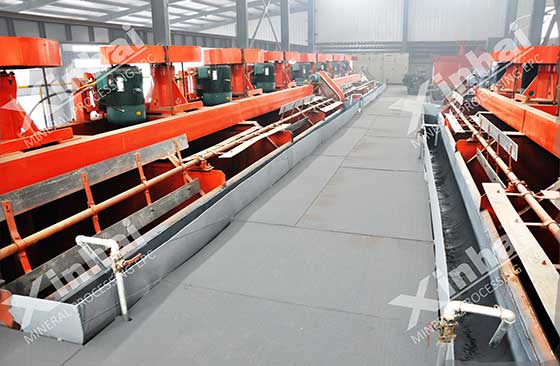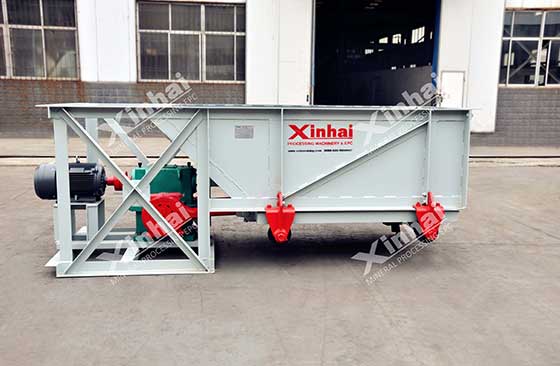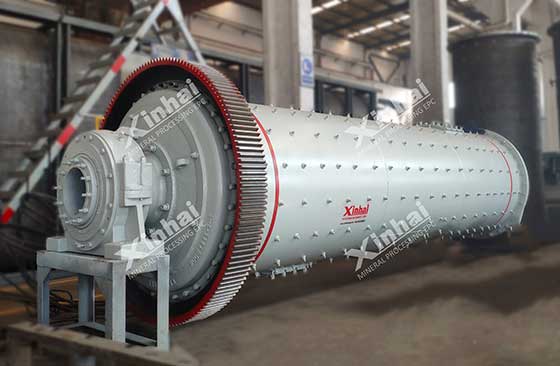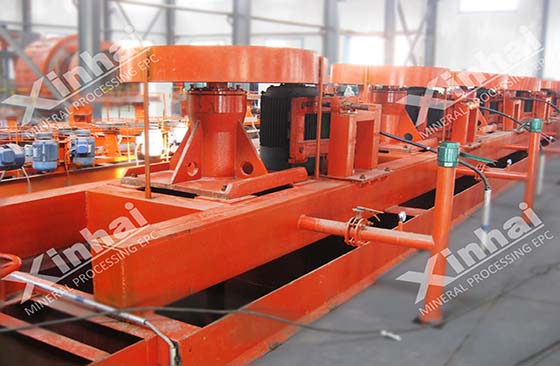
Molybdenum is a metal element discovered later. As an important metal resource, it has the advantages of high strength, high melting point, corrosion resistance and grinding resistance. Molybdenum metal is widely used in industrial fields. As a result, the demand for molybdenum metal is also increasing. Obtaining high-quality molybdenum concentrates has long been a focus of concentrators. In this article, Xinhai will introduce a detailed molybdenum production process for you. Its process can be divided into: crushing and screening process, grinding and classification process, flotation separation process and concentration and dehydration process.

The crushing and screening stage of molybdenum ore mainly adopts two stages and one closed circuit crushing and screening process. The main process is: the molybdenum ore in the raw ore silo enters the jaw crusher for coarse crushing through the trough feeder, and the coarsely crushed molybdenum ore is transported to the circular vibrating screen by the belt conveyor for screening, and the screen material enters the fine ore silo to be stored, and the oversize material is returned to the crushing stage for fine crushing because the ore particle size does not meet the requirements. Generally, a cone crusher is used for fine crushing. After crushing, the ore discharged from the cone crusher and the ore discharged from the jaw crusher are sent to the circular vibrating screen for processing.

In the grinding and classification of molybdenum ore, in order to improve the working efficiency of the ball mill and the recovery rate of concentrate, the concentrator generally adopts the second-stage grinding and classification operation. The specific process of the first grinding and classifying stage is as follows: the molybdenum ore stored in the powder ore bin enters the ball mill through the action of the belt feeder and the belt conveyor for grinding. After grinding, the slurry enters the pump box and is pumped into the hydrocyclone by the slurry pump for classification. The overflow part enters the stirring tank. The underflow part is returned to the ball mill for regrinding. The second-stage grinding and classifying operation process is the same as that of the first-stage, which is generally carried out after the first-stage sweeping separation process.

Consistent with the above-mentioned grinding and classifying operations, the flotation process of "one coarse and one fine" will be used for the flotation of molybdenum ore. In order to improve the flotation efficiency, flotation reagents can be added to the high-efficiency mixing tank. The type of flotation reagent added is determined by the property of the mineral itself. The fully stirred pulp is transported to the flotation machine for a rough separation. During flotation, the bubbles in the flotation machine will collide with the ore particles dynamically, and the combination of the bubble particles will be statically separated. In this way, the molybdenum ore concentrate particles can be separated from other substances, which is more conducive to the separation of molybdenum ore. The remaining material is sent to tailings for disposal. The first stage of selection is after the second stage of grinding and classification, aiming to improve the concentrate quality and recovery rate. The process is consistent with a sweep selection.

The molybdenum concentrate obtained after flotation contains a lot of water. In order to meet the production standard, it is necessary to use a high-efficiency thickener to remove the water in the concentrate. Concentrated ore slurry after underflow concentration flows into the pump box, and is pumped into the filter press by the slurry pump for re-dehydration. The filter cake after pressure filtration is molybdenum ore concentrate, which is stored in the filter cake tank. The overflow water of the concentrator and the filtrate of the filter press can be returned to the system for reuse.

The above is the detailed molybdenum production process flow. The above process design and equipment configuration are for reference only. Because the mine is different, the characteristics and composition of the ore are different, the design of the beneficiation process and the configuration of the equipment are also different. It can be seen that the beneficiation test is necessary before the design of the beneficiation process. Xinhai, as the initiator and practitioner of the whole mining industry chain service (EPC+M+O), we can provide you with advanced and reliable mineral processing tests. At the same time, we can also design suitable molybdenum beneficiation process for you, customize efficient beneficiation equipment, and provide perfect after-sales installation and commissioning services. If necessary, welcome to consult Xinhai.
To find out more about our products and solutions, please fill out the form below and one of our experts will get back to you shortly.